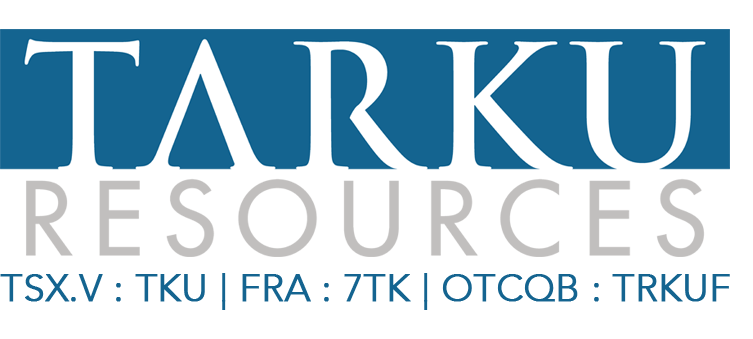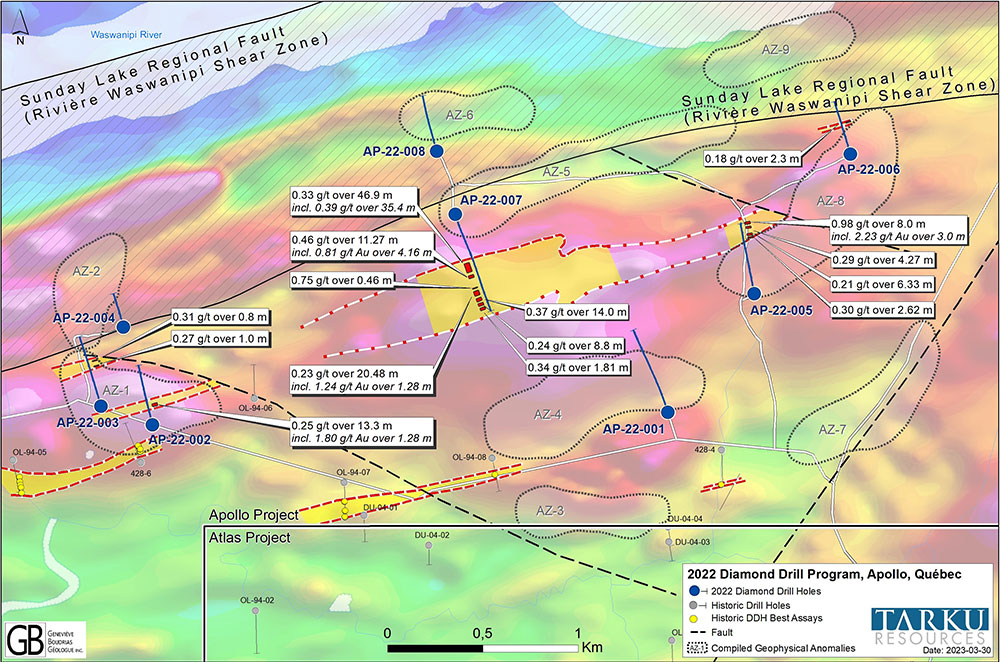Tarku Confirms the Presence of a Strong Gold-Bearing Orogenic System over a 3 km Strike Length on Apollo
![]() Download PDF version | View all documents on Sedar
Download PDF version | View all documents on Sedar
- First-ever drilling program on Apollo successful in identifying a strong gold-bearing orogenic system along the Sunday Lake Fault similar to the Detour Lake Mine
- Drilling hit wide gold intervals covering an interpreted 3-km strike length
- Hole AP-22-07 intersected four gold-bearing structures over 10 metres wide between 300 and 550 m depth, including 46.9 m at 0.33 g/t Au, 11.27 m at 0.46 g/t Au, 20.48 m at 0.23 g/t Au and 14.0 m at 0.37 g/t Au, with mineralization at the end of the hole
- All structures remain open along strike and at depth, with the property hosting abundant dykes and an intrusive stock with alkaline compositions
MONTREAL, April 4, 2023. Tarku Resources Ltd (TSXV: TKU | FRA: 7TK | OTCQB: TRKUF) (the “Company” or “Tarku”) is pleased to confirm the presence of a strong gold-bearing orogenic system identified over a 3-km strike length during its 2022 drilling campaign on its Apollo project. One of the “3As”, which comprise a total of 217 claims covering about 130 square kilometres, Apollo is wholly owned by Tarku and straddles 20 km of the Sunday Lake Fault, host of the Detour Lake Mine.
Julien Davy, President and CEO of Tarku Resources, said: “This first drilling program on Apollo was a true success, as wide altered gold-bearing structures were intersected on four of six target areas, enabling us to confirm the presence of an orogenic system with similar characteristics to the Detour Lake mine system. The discovery hole AP-22-07, drilled on the edge of a magnetic high, is of particular interest as it intersected four significant structures, each more than 10 metres wide. The extensive alterations observed and the long, continuous gold intersections relating to a regional deformation zone associated with syenite intrusions are features of the type of deposit Tarku is looking for. Now that we know we have a gold-bearing system on Apollo, we will do more drilling in that area to confirm its potential both along strike and at depth. Our next drilling program will also focus on confirming the continuity of the gold-bearing structures identified thus far.”
First drilling program on the Apollo project
In December 2022, Tarku carried out an initial drilling program on its Apollo project, consisting of 3,048 m in eight holes on a 4-km-wide priority area along the Sunday Lake Deformation Zone, where no prior exploration for gold had ever been reported. The targeted zones corresponded to magnetic and induced polarization anomalies between surface and 577 m depth. Visual inspection of the core reveals intensive hydrothermal alteration similar in style to orogenic gold deposits, as well as magmatic alteration, including hematization, carbonatization and sericitization.
The results (table 1) reveal several >10 m sections of anomalous gold-bearing rock associated with very finely disseminated cubic pyrite within pervasive silicification and/or quartz stockwerk systems.
Table 1: Best results of first drilling program on Apollo
| Hole # | From (m) | To (m) | Width (m)* | Au (g/t) | Comment |
|---|---|---|---|---|---|
| AP-22-002 | 116.27 | 129.57 | 13.30 | 0.25 | Strong pervasive silicification zone including 5-7% finely disseminated pyrite, locally brecciated and at the contact of a syenite |
| incl. | 116.27 | 122.85 | 6.58 | 0.40 | |
| incl. | 116.27 | 117.55 | 1.28 | 1.80 | |
| incl. | 128.30 | 129.57 | 1.27 | 0.53 | |
| AP-22-002 | 224.00 | 224.50 | 0.50 | 0.25 | Small silicification zone at the contact of an intermediate intrusion |
| Ap-22-003 | 199.00 | 200.00 | 1.00 | 0.27 | Potentially associated with mm quartz veinlets |
| Ap-22-003 | 226.00 | 226.80 | 0.80 | 0.31 | Small silicification zone at the contact of a syenite |
| AP-22-005 | 295.00 | 297.62 | 2.62 | 0.30 | Pervasive silicification zone with finely disseminated pyrite within quartz stockwork at the contact of a brecciated syenite |
| AP-22-005 | 307.67 | 314.00 | 6.33 | 0.21 | |
| AP-22-005 | 342.73 | 347.00 | 4.27 | 0.29 | Strong pervasive silicification zone including 2% finely disseminated pyrite, locally brecciated and at the contact of a strongly hematized syenite |
| AP-22-005 | 362.00 | 370.00 | 8.00 | 0.98 | Strong pervasive silicification zone including 5-7% finely disseminated pyrite, locally brecciated and at the contact of a syenite |
| incl. | 363.00 | 366.00 | 3.00 | 2.23 | |
| incl. | 363.00 | 364.00 | 1.00 | 5.75 | |
| AP-22-006 | 192.70 | 195.00 | 2.30 | 0.18 | Low gold intersection associated with typical silicification and hematization alteration zone with finely disseminated 10% pyrite |
| AP-22-007 | 247.71 | 247.93 | 0.22 | 0.29 | Disseminated pyrite within alternation of silicification lapilli tuff and polygenic conglomerates sequences |
| AP-22-007 | 303.10 | 350.00 | 46.90 | 0.33 | Wide zone of pervasive silicification with finely disseminated pyrite and quartz stockwork. Fuschite has been identified in this section. |
| incl. | 303.10 | 338.50 | 35.40 | 0.39 | |
| incl. | 307.00 | 313.00 | 6.00 | 0.56 | |
| incl. | 319.00 | 334.00 | 15.00 | 0.49 | |
| AP-22-007 | 371.38 | 382.65 | 11.27 | 0.46 | Strong pervasive silicification zone including 1-2% finely disseminated pyrite, locally brecciated and at the contact of a hematized syenite |
| incl. | 375.84 | 380.00 | 4.16 | 0.81 | |
| AP-22-007 | 440.92 | 441.38 | 0.46 | 0.75 | Silicification contact between mafic tuff and syenite |
| AP-22-007 | 457.52 | 478.00 | 20.48 | 0.23 | Strong pervasive silicification zone including 1% finely disseminated pyrite with local quartz stockwerk locally brecciated |
| incl. | 457.52 | 458.80 | 1.28 | 1.24 | |
| AP-22-007 | 495.50 | 509.50 | 14.00 | 0.37 | Strong pervasive silicification zone including 3-4% finely disseminated pyrite, with quartz stockwerk |
| incl. | 495.50 | 497.00 | 1.50 | 2.84 | |
| AP-22-007 | 525.00 | 533.80 | 8.80 | 0.24 | Silicification contact between mafic tuff and syenite |
| AP-22-007 | 547.80 | 549.61 | 1.81 | 0.34 | Silicification contact between mafic tuff and syenite |
Figure 1: Apollo hole location map
Similar orogenic gold deposit model to the Detour Lake mine
The regional Rivière Waswanipi shear zone is the eastern extension of the Sunday Lake Fault, which hosts the >20 million ounces Detour Lake gold mine and the Kirkland Lake mining camp, which has produced over 50 million ounces of gold. Similar to the Sunday Lake Fault, the Rivière Waswanipi shear zone is characterized by the presence of alkaline rocks, polygenic conglomerates (Timiskaming-type) and porphyry intrusions bearing anomalous gold values on the order of hundreds of parts per billion (GM 52712).
The 3As projects were acquired in 2016, as Tarku staked open ground, based on a detailed data compilation exercise in the region. This process also took into account the historical zinc mining district of Matagami (4.6 million tonnes Zn and 0.494 million tonnes Cu from 1960 to 2004) and especially, the overlooked potential for gold mineralization.
After Tarku acquired the properties, it carried out a till sampling program. Statistical analysis revealed three different populations within the gold assay results, given 93% gold background of values between 0.25 g/t and 0.35 g/t Au. Several mineralogical characteristics were also found as the geochemical signature of the gold-bearing zones that correlate with Te (0.86), Ag (0.80) and Mo (0.76).
Along the same regional structure, other explorers, such as Maple Gold, Balmoral and Midland Exploration, have returned exciting drill results and demonstrated the strong gold potential of the area.
Drilling sampling method and QA/QC
Diamond drilling was done by Forages Rouillier of Amos, Quebec. All the NQ-size core is recovered by the drillers, sent to the Matagami core shack and logged by the geologists. Samples generally vary from 0.5 m to 1.5 m depending on the geological environment. Sample preparation is then done by Service MNG, where the drill core is sawed in half, with one half used for chemical analysis and the other half for control purposes.
All samples are sent to the Actlab Laboratory in Val-d’Or, Quebec, for analysis. Each sample is dried and crushed to 80% passing -2mm (10 mesh) and 300 g are taken to be pulverized to 85% passing 75 microns (200 mesh). Gold analysis (TMT-G5B method) is performed by fire assay on 50 g samples with an atomic absorption finish. Samples exceeding the detection limit of 3,000 ppb are reanalyzed by fire assay with a gravimetric finish. The sample is then treated by four-acid digestion and analyzed by ICP-MS for 60 elements, including silver (Ag), copper (Cu), lead (Pb) and zinc (Zn).
Quality assurance/quality control (QA/QC) includes the use of duplicates representing one quarter (1/4) of the drill core, blank samples and material certified for Au, Ag and Cu. QA/QC additions to the sample stream total an additional 10% of samples analysed.
A total of 2,178 samples were taken and analysed for gold and the 60 elements and 14 samples were analysed for lithogeochemistry.
Qualified persons
Julien Davy, P.Geo., M.Sc, MBA, President and Chief Executive Officer of Tarku and a qualified person under National Instrument 43-101 on standards of disclosure for mineral projects, has prepared, supervised and approved the technical information in this news release.
About Tarku
Tarku Resources Ltd. (TSXV: TKU | FRA: 7TK | OTCBQ: TRKUF) is a mining exploration company focused on advancing the development of new discoveries by using modern techniques in favourable mining jurisdictions such as Quebec and Arizona.
In Arizona, within the famous Tombstone District, Tarku owns 100% of the 29 km2 Silver Strike project. Silver Strike has been interpreted by management to have the potential for similar Carbonate Replacement Deposits (CRD) comparable to the Hermosa project, located 80 km west in Santa Cruz County, Arizona, which South32 acquired for USD 1.8 billion in 2018.
In Quebec, Tarku owns 100% of the “Three As” exploration projects (Apollo, Admiral and Atlas) in the Matagami Greenstone Belt, interpreted by management as the eastern extension of the Detour Belt, which has seen recent exploration successes by Midland Exploration, Wallbridge Mining Company and Probe Metals. In addition, the Company owns the MAX Lithium project, located 4 km southwest of Sayona Mining’s North American Lithium mine.
On behalf of Tarku Resources Ltd.
Julien Davy,
President and CEO
Tarku Contact Information:
Email:
Website: www.tarkuresources.com
Please follow @TarkuResources on LinkedIn, Facebook, Twitter and Instagram.
Neither TSX Venture Exchange nor its Regulation Services Provider (as that term is defined in the policies of the TSX Venture Exchange) accepts responsibility for the adequacy or accuracy of this release.
This press release may contain forward-looking statements that are subject to known and unknown risks and uncertainties that could cause actual results and activities to vary materially from targeted results and planning. Such risks and uncertainties include those described in Tarku’s periodic reports including the annual report or in the filings made by Tarku from time to time with securities regulatory authorities.

